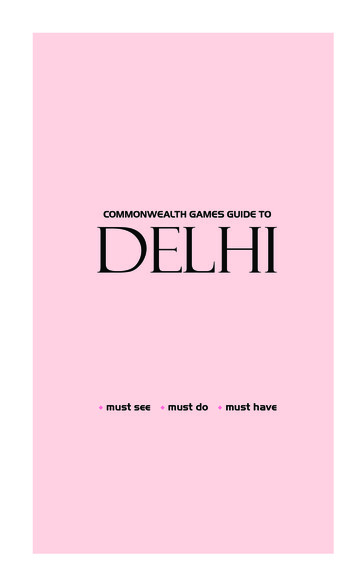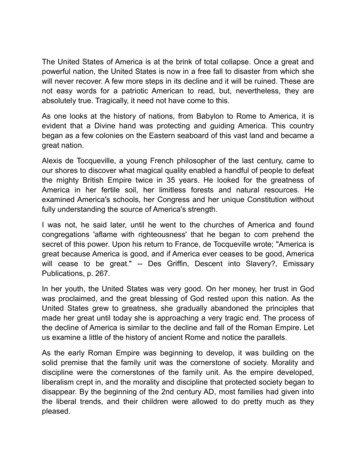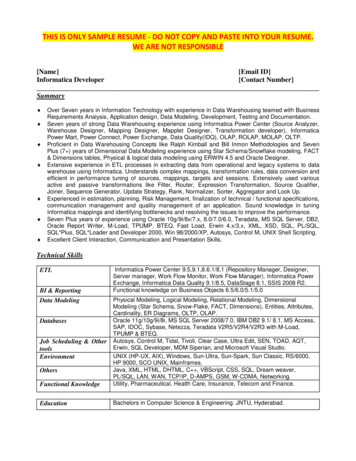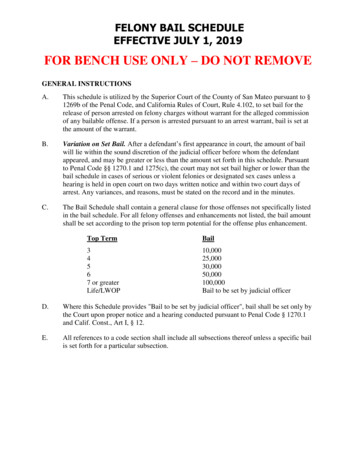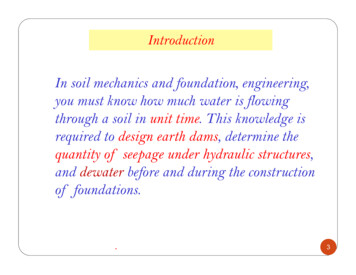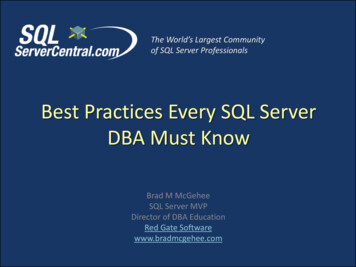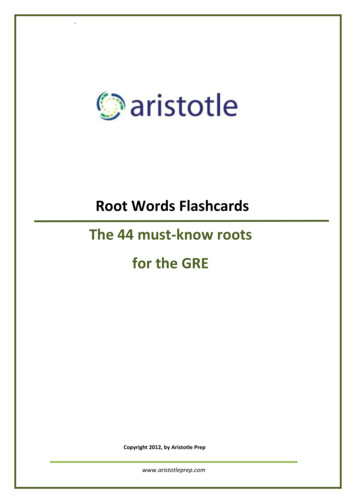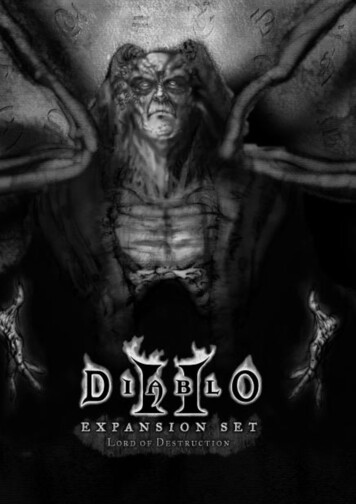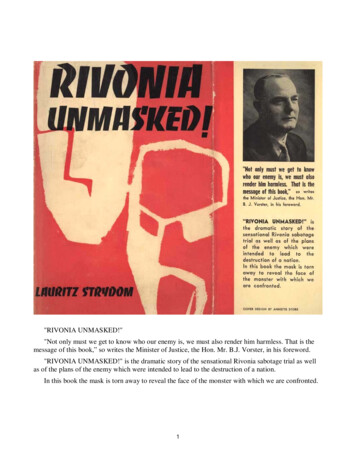
Transcription
"RIVONIA UNMASKED!""Not only must we get to know who our enemy is, we must also render him harmless. That is themessage of this book,” so writes the Minister of Justice, the Hon. Mr. B.J. Vorster, in his foreword."RIVONIA UNMASKED!" is the dramatic story of the sensational Rivonia sabotage trial as wellas of the plans of the enemy which were intended to lead to the destruction of a nation.In this book the mask is torn away to reveal the face of the monster with which we are confronted.1
Rivonia Unmasked!Lauritz StrydomVoortrekkerpers JOHANNESBURG2
FOREWORD BY THE HON. MR. B. J. VORSTERLIFE moves so rapidly and events follow each other with such speed that while one is speculatingon what may happen tomorrow, one actually forgets the incidents of yesterday.Complete reports of court cases and other happenings can often not be given in newspapersbecause of lack of space and interest in a sensational court case can diminish when the proceedings areprotracted for months.This did happen with the Rivonia case and I am pleased, therefore, that the whole matter is relatedin this book in such a concise and interesting manner. The incidents connected with Rivonia and thelessons learnt by those in authority and by others must definitely not be forgotten.We can rejoice as a nation and give thanks to God that the attack on the Republic and its way oflife did not succeed, but unless this results in a much greater watchfulness we shall have gained butlittle. Not only must we get to know who our enemy is, we must also render him harmless.That is the message of this book. It could truly not have been an easy task for the writer to extractthe gist of the matter from the thousands of pages of evidence. Every reader will acknowledge that hesucceeded very well in doing this.This is verily a book which deserves a wide circle of readers and which will certainly obtain them.3
INTRODUCTORY REMARKS BY DR. PERCY YUTARWHEN I delivered my opening address in the so-called Rivonia Trial, the immediate reaction wasthat I had exaggerated the position and resorted to "dramatics" for some ulterior motive. Completesight was lost of the fact that I am not (and never have been) a politician and that, as a lawyer, I amobliged, in terms of our law, to use the testimony to be given, both oral and documentary, as the basisfor whatever I desire to say by way of opening, and that was all I did!As I had occasion to remark in court, I had not at any stage received any instruction whatsoeverfrom the Minister of Justice, or anyone else for that matter, either directly or indirectly, as to who Ishould indict and on what charges: that was my responsibility, and, I may add, if I had to start that casede novo I would do the very same again.Quite apart from what I have read in the statements of witnesses, I myself was deeply shocked byand could hardly believe what I read in documents which were either in the handwriting of the accusedor were found in their possession. These documents clearly revealed that the accused deliberately andmaliciously plotted and engineered the commission of acts of violence and destruction throughout thecountry, directed against the homes and offices of State and municipal officials as well as against alllines and manner of communications. The planned purpose thereof was to bring about in the Republicof South Africa chaos, disorder and turmoil which would be aggravated, according to their plans, bythe operation of thousands of trained guerrilla warfare units deployed throughout the country at variousvantage points. These would be joined in the various areas by local inhabitants as well as by selectedmen posted to such areas. The combined operations were planned to lead to confusion, violentinsurrection and rebellion followed at the appropriate juncture by an armed invasion of the country bymilitary units of foreign powers. In the midst of the resulting chaos, disorder and turmoil, it wasplanned by the accused to set up a provisional revolutionary government to take over theadministrative control of this country. The accused admitted the authenticity of all these documents,and also that their policy included the eventual overthrow of the Government of South Africa byviolence. It is because of this that I submitted to the Court that this was a case of high treason parexcellence, and it was on those facts found proved which constituted the crime, no matter by whatname the crime may be called, that the accused were duly found guilty.In the main the documents provide more than adequate proof of each and every allegationcontained both in the indictment and in the opening address, including(a) the involvement of Moscow, the Communist Parties of Algeria, China, Czecho-Slovakia, EastGermany and several other countries in respect of the provision of financial assistance, arms,ammunition and military personnel, but, of course, this was to be kept secret for fear of internationalrepercussions;(b) the fact that the African National Congress was completely dominated by the Communist Partyof South Africa, and that between them they spoke for less than I of the entire population of SouthAfrica. The fact of this domination was also to be kept secret from the rank and file of the AfricanNational Congress, and(c) the collection of large sums of money from persons and bodies of persons, in so far as thedonors were not apprised of the facts set out in (a) and (b) above, nor of the fact that the moneys wereto be used for the purpose of sabotage and revolution in this country.So strong was the documentary proof that it was barely necessary to adduce oral testimony insupport of the various allegations made by the State, and for that reason I called as witnesses less thanone half of the number of persons from whom statements had been taken by the Police. For that very
same reason too, I deemed it sufficient to set out in three of the four volumes comprising the State'sconcluding address a factual analysis of the documentary exhibits and the oral testimony without anycomment whatsoever: only in the fourth volume was a critical analysis attempted and then only inregard to documents dealing with military matters and explosives. In my view the documents spokemore eloquently that I could ever hope to do by way of critical comment. No wonder then that duringthe course of a hearing for bail, I declared that never in all my experience had the police presented mewith a stronger case against an accused than in this case!Certain aspects of the case distressed me.Firstly, Alexander Hepple. He begged the police to be allowed to see me, offered to give evidencefor the State, and even typed his own statement which contained a host of important matters, as well ashis admission that he was a member of the Communist Party of South Africa, and as a measure of hisbona fides he pointed out to the police the hiding place of Goldreich and Wolpe at Mountain View. Iallowed him to see me and consult with the leader of the Johannesburg Bar and others to one of whomhe subsequently wrote saying that he was satisfied that the course he had decided on was the right one.Just before his release, I told him that I could arrange for his further detention until he had testified, orhave him watched. He replied that neither was necessary and gave me his word of honour that hewould not abscond. He did! Such is the reliance one can place on the word of honour of a communist.Secondly, Albert Luthuli– a man acclaimed by the world as a man of peace and in fact awarded theNobel Prize for peace. Yet the documents showed that he was consulted about the new policy ofviolence and sabotage, that he approved thereof, and gave it his blessing, and that he was kept in touchwith the position.Thirdly, Alan Paton– a man who had won acclaim in a literary world and as a liberal thinker. Neverhave I seen a man head for the witness box so quickly even before his counsel had called his name. Heknew, of course, that what he was to say would be publisized throughout the world. He did not know,of course, that I had a complete dossier on him compiled by the police. He advocated, whilst abroad,certain stern measures against the country of his birth, which he realised would seriously affect thevery people whose cause he professed to have at heart and already in 1960 knowingly spoke ofsabotage which broke out only a year later. He professed to be a prophet. I doubted it, because he hadclose contact with vicious, communistic and anti-South African literature, as well as with a number ofwell-known communists and traitors of South Africa. That is why I took the unusual step of crossexamining him.My learned colleague, Mr. T. B. Vorster, and I have independently read the chapters that followand in so far as they deal with the facts of the case as disclosed during the trial, they have been set outcorrectly and accurately.I very much doubt whether there will ever be another Rivonia, but that is no reason why theRivonia trial with all its sensational disclosures should be lightly glossed over or even forgotten. It ishard to believe that from at least three points in the very heart of Johannesburg– Rivonia, Travallyn,and Mountain View– a hellish and violent revolution should have been plotted, and that some of theplotters, such as Goldreich, should have passed in business and social circles as harmless, innocentmen! But for the South African police in general, and for the Security Branch in particular, SouthAfrica would today have found itself embroiled in a bloody and savage revolution. For that reason Iconcluded my address in court, as I do this introduction, by sincerely saying that the public of SouthAfrica owes a great debt of gratitude to the South African police.5
1 VITAL INFORMATIONTHE epidemic was assuming alarming proportions. These were no isolated outbreaks, that muchwas certain. The plague would strike in one spot to-day, to-morrow in a place many miles distant.Nevertheless the Security men who had been battling for the past eighteen months to check thescourge, knew that these outbreaks all proceeded from a central source; and not until this source hadbeen uncovered could effective counter measures be instituted.The name of the plague was Sabotage.As often as not, the perpetrators remained unknown. An occasional one was caught, brought totrial, and sentenced to a term of imprisonment. But the men who had to fight the epidemic knew thatthese few were only small fry, mere tools, whose capture would make little difference to the spread ofthe scourge. While the leaders remained at large, the spate of subversive activity would continue.The leaders lurked safely in their hiding places, which might be anywhere, anywhere at all, in thisvast country. They were safe enough, these leaders, invulnerable because anonymous; for not eventheir followers, whose function was to carry out orders, knew their identity. How could they? The rootsof the underground movement burrowed deep; they spread far and in many directions. The ordinarymembers did not even know their immediate superiors, the men of the Regional Command. They hadno means of recognising the members of other groups operating elsewhere. The organisation wasperfect, operating on the cell system, in complete darkness and secrecy. The members received theirorders and carried them out unquestioningly.But if the leaders of the underground movement were subtle and cunning, the Police Force,composed of non-White as well as White members, was no less so. The cream of this Force is theSecurity Branch, a picked body of men, keen-sighted and sharp of hearing, whose eyes and ears areeverywhere.Many pieces of the giant jig-saw puzzle were still missing; but from the few pieces the police hadmanaged to collect, little bits of the picture were emerging. Only little bits– but enough to give themsome idea of what the composite picture looked like. The Security Branch began to form some shrewdsuspicions as to the identity of the mysterious leaders, the men behind this spate of sabotage.Yet another handful of jig-saw pieces came to light when a number of Bantus were apprehendedduring an attempt to cross the border illegally into Bechuanaland. Several of them made statements tothe police in which they admitted that the African National Congress (banned in 1960, after theSharpeville incident), had arranged to send them abroad for military training.Early in 1963 a pamphlet appeared in the letter boxes of many White persons. Issued by theAfrican National Congress, it read:LISTEN, WHITE MAN!Five Whites were murdered in the Transkei, another hacked todeath at Langa. Sabotage erupts every other week throughoutthe country, now here, now there. The Whites are turning viciousand panicky. At this rate, within a year or two South Africawill be embroiled in the second, bloodier, more furious,Algerian war.SABOTAGE AND MURDERS MULTIPLIED LAST YEAR. SABOTAGE AND MURDERWILL NOT CEASE.6
YOU now face an indefinitely long future of terror, uncertaintyand steadily eroding power. You will keep a gun at your side,not knowing whom to trust. Perhaps the street-cleaner is asaboteur, perhaps the man who makes your tea at the office has agun. You will never be safe and you will never be sure.YOU WILL HAVE LAUNCHED A WAR YOU CANNOT WIN.That the ANC had continued underground after its banning was, of course, a fact long known to thepolice. But now another name began to obtrude itself: Umkhonto We Sizwe, meaning 'Spear of theNation'. The police were hardly surprised to discover that this organisation was in effect the militarywing of the allegedly non-violent ANC. December 16th, 1961, saw a vicious spate of sabotagethroughout the country. On the same day placards appeared on walls and poles in various Bantutownships: the Manifesto of Umkhonto we Sizwe.The placards announced that the 'Spear of the Nation' was a new organisation, founded by Bantusbut admitting persons of all races, and that its aim was to pursue the
The lurid flames eat hungrily into the arms of a 77-year-old woman, into the face of a three-year- old child. In all, twenty-three people are injured. For days and nights teams of doctors and nurses work ceaselessly, battling for the lives of the victims. 77-year-old Mrs Rhys succumbs to her injuries.
